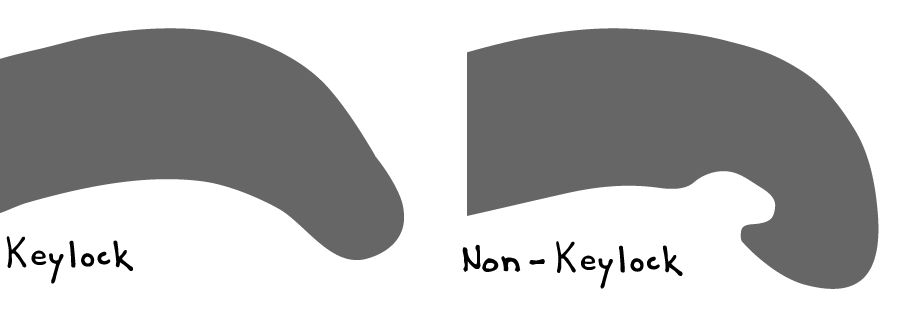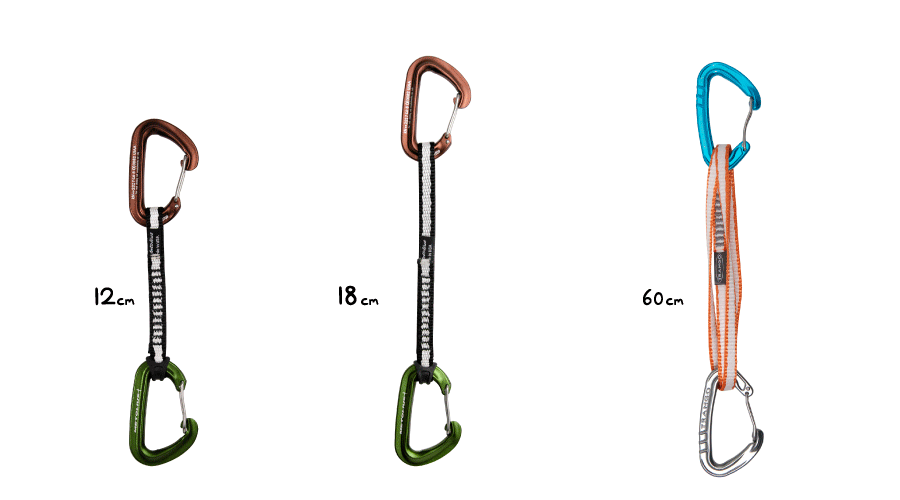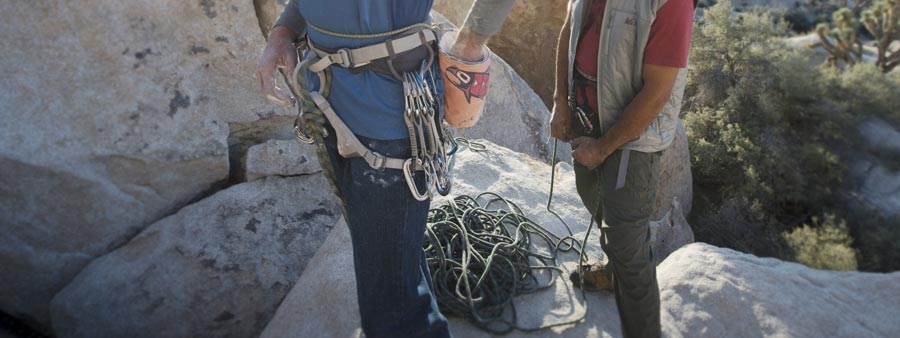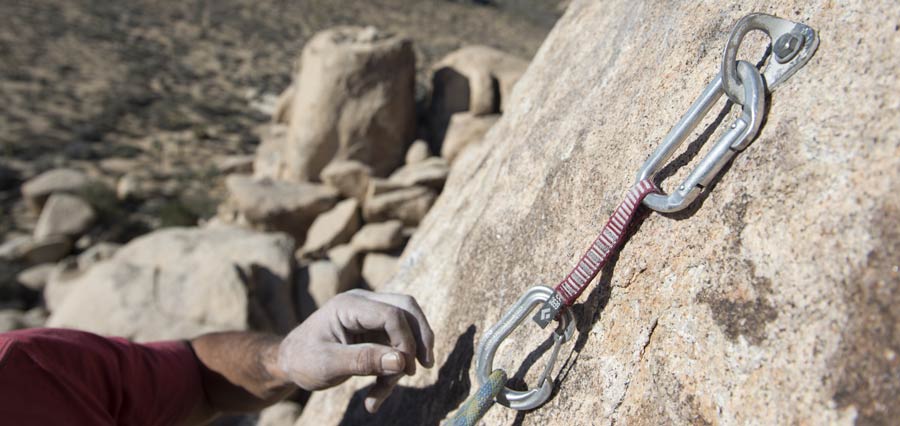Once you have rock shoes, a harness, belay device, locking carabiners and a helmet, your next logical gear purchase is a few sets of quickdraws.
When you're shopping for quickdraws, you have three main considerations:
- Carabiner gates
- Sling length
- Quantity
Additional considerations: Subtler quickdraw features like carabiner size and shape, sling width, sling material, weight and strength can also be important, especially as you become more experienced.
Your choices involve tradeoffs in weight, strength or ease of use. For example, a quickdraw with tiny wiregate carabiners and a flimsy sling will barely weigh anything, helping keep your gear rack light and nimble. But, this type of quickdraw will also be harder to clip than a heavier one with large carabiners and a stiff sling.
Consider also the type of climbing you do and your priorities. Features that make a quickdraw great for one type of climbing might not make it so great for another. That superlight quickdraw might be awesome for multi-pitch adventures where every gram counts, but not so awesome on a single-pitch sport climb at the crag, where weight is a lower priority.
Carabiner Gates

The three primary types of gates on quickdraw carabiners are straight, bent or wire. Because each quickdraw has two carabiners on it, a quickdraw could have a combination of straight, bent and/or wiregate carabiners.
Straight-gate carabiners: Common on many quickdraws, these carabiners have solid straight gates that are easy to operate. As the name implies, straight gates are perfectly straight from the pivot point to the end.
Bent-gate carabiners: These have a concave gate that makes clipping a rope quick and easy, and for this reason they are reserved only for the rope-end of quickdraws.
Some straight- and bent-gate carabiners are also keylock carabiners. A keylock carabiner has a smooth notch where the nose of the carabiner and the gate interact. This keeps the carabiner from hooking and catching on your harness gear loop, bolt hangers and other slings, any of which can be quite annoying. You'll likely pay a little extra for this feature, but it's a nice upgrade.
Wiregate carabiners: Wiregate carabiners use a loop of stainless-steel wire for a gate. The wire loop creates its own spring mechanism as it pivots, decreasing overall weight and eliminating the need for extra parts found in solid gates.
An advantage of the low mass of the wiregate is that it is less likely that the gate will vibrate open during a fall than a solid gate. This momentary opening caused by inertia or a collision with another object is called gate lash and it can reduce the carabiner's overall strength to its open-gate strength. Wiregates are also less likely than solid gates to freeze up in cold temperatures, so if you ice climb or mountaineer, you'll probably prefer them.

By design, wiregate carabiners cannot have the keylock feature that some straight- or bent-gate carabiners have. However, some wiregates have "hooded" noses that keep them from snagging on gear, similar to the keylock nose.
Sling Length

The next thing most climbers consider when picking out quickdraws is the length of the sling (sometimes called a dogbone). Longer slings are more effective at reducing rope drag, but they're also heavier and bulkier.
Sport climbers often buy pre-made quickdraws that are available with different-length slings:
- 10 - 12cm slings: These short-length slings work in most situations when the route is relatively straight.
- 17 - 18cm slings: These medium-length slings are useful for reducing rope drag, especially when the route is more than 12 quickdraws long or if the rope is not traveling in a straight path.
Sport climbers find it helpful to have a selection of both short- and medium-length quickdraws on their harness so they're ready for whatever the route has in store.
Trad climbers often make their own quickdraws rather than buying pre-made ones. You can do this by taking a 60cm or longer sewn sling and clipping two carabiners of your choice to the sling. Climbers call these alpine quickdraws or extendable quickdraws ("extendable" refers to a technique for racking the quickdraw so that the sling can be shortened and then extended if needed.
Quantity

The number of quickdraws you need will vary depending on what, where and how long your climb will be. Here are some suggestions:
- Most sport routes can be led with 12 quickdraws, so this is a good start.
- Longer sport routes (more than 30m long) require 16 to 18 quickdraws
- Exceptionally long routes require 24 or more quickdraws
- Routes requiring a 70m rope or longer require more than 12 quickdraws.
- When a guidebook lists the number bolts on a route, that's also your quickdraw total.
- If you plan to use quickdraws as part of your anchor, also account for that.
- It never hurts to carry a couple of extra quickdraws on your harness.
Additional Considerations
Carabiner Size
The smaller the carabiner, the lighter it is, but also the more difficult it can be to manipulate (i.e., unclipping the quickdraw from your harness and clipping the bolt or rope.)
Carabiner Shape
This can also affect ease of use, especially if you have large hands. How and where you climb can determine whether you go with a smaller, lighter carabiner or a larger, heavier carabiner that may be easier to clip.
You can find carabiner dimensions listed on the Specs tab on REI product pages, but your best approach is to go to REI or other local climbing shop to hold the carabiners and get a feel for how they will work with your hands.
Carabiner Gate Open Clearance
This refers to the width that the gate can open, plus the depth and shape of the bottom of the carabiner below the gate. Generally the smaller the carabiner, the less clearance it offers.
Too little gate-open clearance may lead to your finger getting stuck between the gate and the carabiner body while clipping; too deep a clearance can also make the carabiner difficult to clip. An ideal amount makes clipping the rope into the carabiner easy. Again, go to your local climbing shop and see what works for you.
Overall Weight
Quickdraws range from around 60 to 110g. Weight adds up quickly when you're carrying lots of climbing gear, so saving weight can give you an advantage on long, challenging sport climbs and fast-and-light alpine climbs.
But before you buy a bunch of the lightest quickdraws on the market, think about the downside of saving weight. Lighter carabiners are smaller, which can make them harder to clip. And, while all carabiners meet UIAA and CE requirements, smaller carabiners can be weaker than larger ones, making them more susceptible to bending if loaded over an edge.
Sling Material
The material used to make the sling (sometimes called a dogbone) affects the overall weight of a quickdraw.
Slings are typically made from nylon, polyester, ultra-high-molecular-weight (UHMW) polyethylene or some combination of these. UHMW polyethylene (Dyneema, Spectra and Dynex are common brand names for UHMW polyethylene) is inherently stronger than pure nylon or polyester, which allows slings to be made much lighter and narrower while providing the UIAA-required minimum strength of 22 kN.
So, if low weight is a priority for you, look for quickdraws with slings made with UHMW polyethylene. But, expect to pay a bit more for these.
Sling Width

We already discussed the importance of sling length, but it's worth mentioning the width, too. The width of a sling impacts the overall weight of a quickdraw as well as the ease of use. Skinnier slings are lighter, but they also tend to be a bit harder to handle than a wider, stiffer sling.
The narrowest slings are about 8mm, while the widest are about 25mm. When you look at sling width, consider the type of climbing you're doing. Are you climbing routes where quickdraws with superlight skinny slings will give you an advantage, or would you benefit from having quickdraws with wider, stiffer slings that are easier to grab off your harness and will tend to hold up better over time?
Carabiner Strength
Carabiners are rated for strength in three directions: lengthwise (major axis), sideways (minor axis) and while open (major axis open or "gate open"). These ratings are typically marked on the spine of the carabiner.
All climbing carabiners pass UIAA and CE standards, which means they are plenty strong as long as you use them correctly. Because of this, you don't need to concern yourself too much with strength when choosing quickdraws, but it is an attribute that some climbers like to examine when comparing products. Gate-open strength and minor-axis strength are where you see the most variation.
Here's how you might use strength ratings: If you've narrowed your search to two or three different quickdraws that will work well for your style of climbing, look at the strength ratings as one of the final decision points. If one quickdraw provides everything you need and is stronger than the others, then you might as well go with that one. Keep in mind that smaller and lighter carabiners are generally weaker than bigger, heavier ones, but not always.
Always remember: Your safety is your responsibility. No article or video can replace proper instruction and experience. Make sure you're practiced in proper techniques and safety requirements before you climb.
